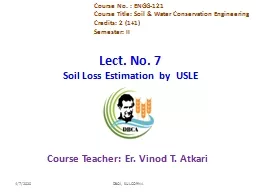

Soil Loss Estimation by USLE Course Teacher Er Vinod T Atkari Course No ENGG121 Course Title Soil amp Water Conservation Engineering Credits 2 11 Semester II Estimation of Soil loss due to water sheet amp rill erosion ID: 932591
Download Presentation The PPT/PDF document "4/7/2020 DBCA, SULCORNA Lect. No. 7" is the property of its rightful owner. Permission is granted to download and print the materials on this web site for personal, non-commercial use only, and to display it on your personal computer provided you do not modify the materials and that you retain all copyright notices contained in the materials. By downloading content from our website, you accept the terms of this agreement.
Slide1
4/7/2020
DBCA, SULCORNA
Lect. No. 7
Soil Loss Estimation by USLE
Course Teacher: Er. Vinod T. Atkari
Course No. : ENGG-121
Course Title: Soil & Water Conservation Engineering
Credits: 2 (1+1)
Semester: II
Slide2Estimation of Soil loss due to water (sheet & rill) erosion
Soil erosion is potential threat to soil productivity
Decreases nutrients and water available to plants
Estimation of soil losses helps to farmers in planning4/7/2020DBCA, SULCORNA
Slide34/7/2020
DBCA, SULCORNA
The dimensions of study plot was 22.13 m in length with 9 % slope in continuous fallow condition
Slide44/7/2020
DBCA, SULCORNA
Universal Soil Loss Equation (USLE)
Erosion = f (Climate, Soil, topography, Land use) A= RK (LS) CP A = Average annual soil loss, tonnes/haR = Rainfall erosivity factor/index, (MJ*mm/ha*h)
K = Soil erodibility factor/index for specific soil horizon, (t*ha*h/ha*MJ*mm) LS = Topographic factor, a combined factor for length of slope L and steepness of slope S, (dimensionless)C = Crop Management factor, (dimensionless)P = Erosion Control factor/Conservation practice factor (dimensionless)This above USLE eq. provides estimate of sheet & rill erosion in upland areas. It does not include erosion from stream bank & wind erosion.
Slide54/7/2020
DBCA, SULCORNA
Slide64/7/2020
DBCA, SULCORNA
Slide74/7/2020
DBCA, SULCORNA
Slide84/7/2020
DBCA, SULCORNA
Slide94/7/2020
DBCA, SULCORNA
Slide104/7/2020
DBCA, SULCORNA
The conservation practice consists of mainly the contouring, terracing and strip cropping in which contouring appears to be most effective practice on medium slopes ranging from 2 to 7 per cent.
Slide114/7/2020
DBCA, SULCORNA
Slide124/7/2020
DBCA, SULCORNA
Slide134/7/2020
DBCA, SULCORNA
Slide14Example 1:
Calculate the annual soil loss from a given field subject to soil erosion problem, for the following information: Rainfall erosivity index (R) = 1000 m.tonnes/ha, Soil erodibility index (K) = 0.20
Crop management factor (C) = 0.50, Conservation practices factor (P) = 1.0
Slope length factor (LS) = 0.10, Also explain, how the soil loss is affected by soil conservation practices.Solution: Annual soil loss from the field is computed by using the USLE. A = R.K.L.S.C.P = 1000 x 0.20 x0.1 x 0.5 x 1.0 = 10 tonnes/ha/yearIf soil conservation practice is now supposed to change, for which let the value of factor – P is 0.5, then the annual soil loss will be as:
A = 1000x0.20x0.1x0.5x0.5 A = 5 tonnes/ha/yearThis shows that when the value of factor- P is 0.5 from 1.0, then soil loss is reduced to 5 tonnes/ha/year from 10 tonnes/ha/year.4/7/2020DBCA, SULCORNA
Slide15Example 2:
A field is cultivated on the contour for growing maize crop. The other details regarding USLE factors are as follows:K = 0.40, R = 175 t/acre, LS = 0.70, P = 0.55, C = 0.50
Compute the value of soil loss likely to take place from the field. Also, make a comment on soil loss when same field is kept under continuous pasture with 95 percent cover. Assume the value of factor- C for new crop is 0.003.
Solution: Soil loss, when field is cultivated on the contour with continuous Maize crop. A = RKLSCP A = 175x0.4x0.70x0.55x0.50 tons/acre/year = 13.475 tons/acre/year Soil loss, when field is kept under continuous pasture with 95 percent cover, for which the value of factor – C is given as 0.003 A = RKLSCP A = 175x0.40x0.70x0.55x0.003
= 0.081 ton/acre/year This show that the pasture farming is more effective to control the soil loss, as it covers the land more uniformly and reduces the flow velocity and cumulative volume of runoff, significantly4/7/2020DBCA, SULCORNA
Slide16Example
3: Workout the soil erodibility factor K for the plots given below : Length of runoff plot = 30 m
Slope gradient = 5%R factor = 800
Soil loss from the plot= 50 tonne / ha. LS factor for a plot of 30 m length 92.6 on 5% = 0.54Solution Adjusted soil loss = Observed soil loss (tonnes/ha) tonnes / ha LS factor. =50/0.54Adjusted soil loss =92.6 tonnes / ha
K = soil erodibility factor = Adjusted soil loss(tonnes/ha) R = 92.6/800 = 0.1164/7/2020DBCA, SULCORNA
Slide17Application of USLE
It predicts soil loss (t/ha/year)
It helps in selection of the agricultural practices
Uncontrolled factors: rainfall erosivity index, slope length, steepness factorsControlled factors: Crop management practices (C), Conservation practice factor (P) , C & P can be changed by ploughing, terracing, bunding, contouring, strip cropping etc.3) It provides recommendations on crop management practices to be used for soil conservation
4/7/2020DBCA, SULCORNA
Slide18Limitations of USLE
It is empirical
It predicts average annual soil loss
It does not compute gully erosionIt does not compute sediment deposition4/7/2020DBCA, SULCORNA
Slide19Thank you for kind attention…
4/7/2020
DBCA, SULCORNA